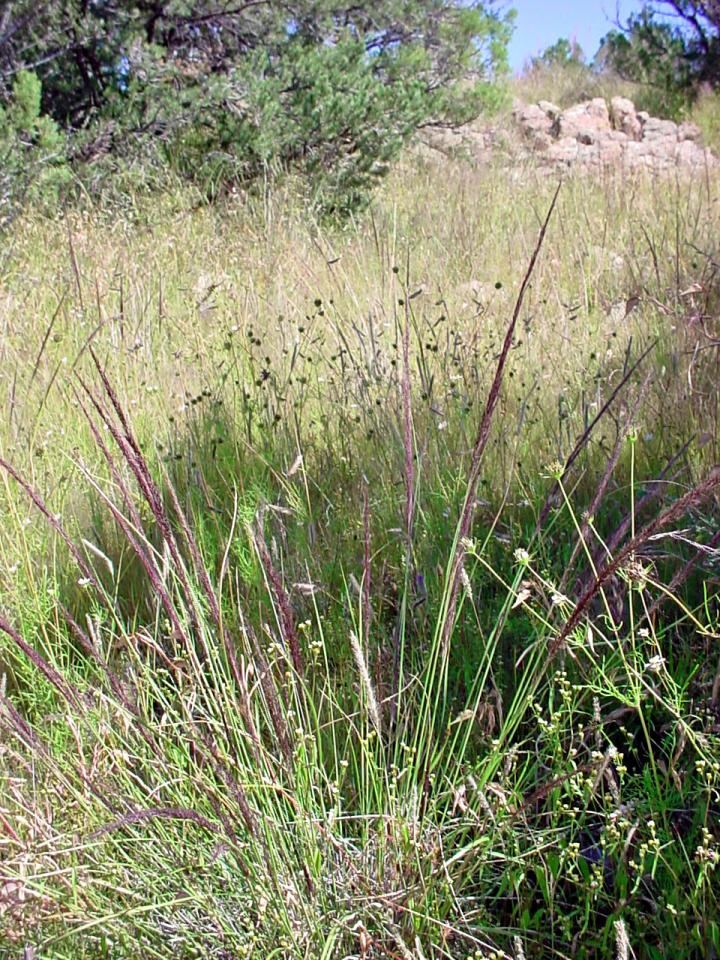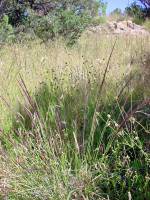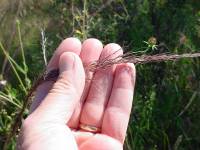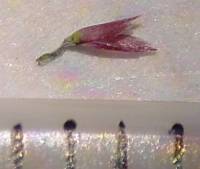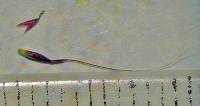Plants perennial; cespitose, not rhizomatous. Culms 40-100 cm, erect, not conspicuously branched; internodes mostly smooth, sometimes scabridulous below the nodes. Sheaths longer than the internodes, smooth or scabridulous, basal sheaths rounded, not becoming spirally coiled when old; ligules (1)3-12(15) mm, firmer basally than distally, obtuse to acute, often lacerate; blades 12-35 cm long, 1-3 mm wide, flat or involute, smooth or scabridulous abaxially, scabridulous or hirtellous adaxially. Panicles 10-35 cm long, 2-5(12) cm wide, loosely contracted to open, purplish; primary branches 0.4-10 cm, lax, capillary, usually appressed to ascending, occasionally diverging up to 80° from the rachises, naked basally; pedicels 1-10 mm. Spikelets 3.5-5 mm, purplish. Glumes equal, 1-1.7(2) mm, exceeded by the florets, usually glabrous, sometimes mostly hirtellous but glabrous distally, 1-veined, obtuse to subacute, unawned; lemmas 3.5-5 mm, narrowly lanceolate, purplish, calluses hairy, hairs to 0.5 mm, lemma bodies scabridulous to scabrous, apices acuminate, awned, awns 10-22 mm, clearly demarcated from the lemma bodies, flexuous; paleas 3.5-5 mm, narrowly lanceolate, scabridulous, acuminate; anthers 1.7-2.3 mm, purplish. Caryopses 2-3.5 mm, fusiform, brownish. 2n = 40, 44.
Muhlenbergia rigida grows on rocky slopes, ravines, and sandy, gravelly slopes derived from granitic and calcareous substrates, at elevations of 1200-2200 m. It is often a common upland bunchgrass, and is also grown as an ornamental plant.
Muhlenbergia rigida grows in two disjunct areas: the southwestern United States south to Chiapas, Mexico, and in Ecuador, Peru, Bolivia, and Argentina. It differs from M. setifolia and M. reverchonii in its purplish, scabridulous to scabrous lemmas.
Common Name: purple muhly
Duration: Perennial
Nativity: Native
Lifeform: Graminoid
General: Tufted perennial in dense clumps from a hard knotty base with stems 40-100 cm, not conspicuously branched, mostly smooth internodes, minutely roughened below the nodes, sheaths rounded at base, not spirally coiled when old.
Vegetative: Blades 12-35 cm long, 1-3 mm wide, flat or involute, smooth or minutely roughened below, minutely roughened or hirtellous above, ligules 3-12 mm, firmer at base than tip, frayed and lacerate at tip.
Inflorescence: Loosely contracted to open panicle 10-35 cm long, dark purplish at maturity, primary branches 0.4-10 cm, lax, capillary, usually appressed to ascending, occasionally diverging up to 80 degrees from rachises, naked basally, with purplish spikelets 3.5-5 mm; glumes equal 1-2 mm, exceeded by the florets, usually glabrous, obtuse to subacute, unawned; lemmas 3.5-5 mm, narrowly lanceolate, purplish, few short hairs to 0.5 mm, bodies minutely roughened to scabrous, apices acuminate, awned with awns 10-22 mm, clearly demarcated from lemma bodies, flexuous; flowers August-November.
Ecology: Rocky slopes, in ravines, and on sandy to gravelly slopes from granitic and calcareous substrates;4,000-7,500 ft (1219-2286 m).
Distribution: se AZ, s NM, w TX; south to s MEX; disjunct in South America.
Notes: Distinguished by being an erect perennial bunchgrass to 1m with contracted to open, diffuse panicles bearing single-flowered spikelets with long awns 10-22 mm, the entire inflorescence turning distinctly purple.
Ethnobotany: Unknown
Etymology: Muhlenbergia is named for Gotthilf Heinrich Ernst Muhlenberg (1753-1815) a clergyman and botanist from Pennsylvania; while rigida means stiff leaved.
Synonyms: Muhlenbergia metcalfei
Editor: SBuckley 2010, FSCoburn 2014


